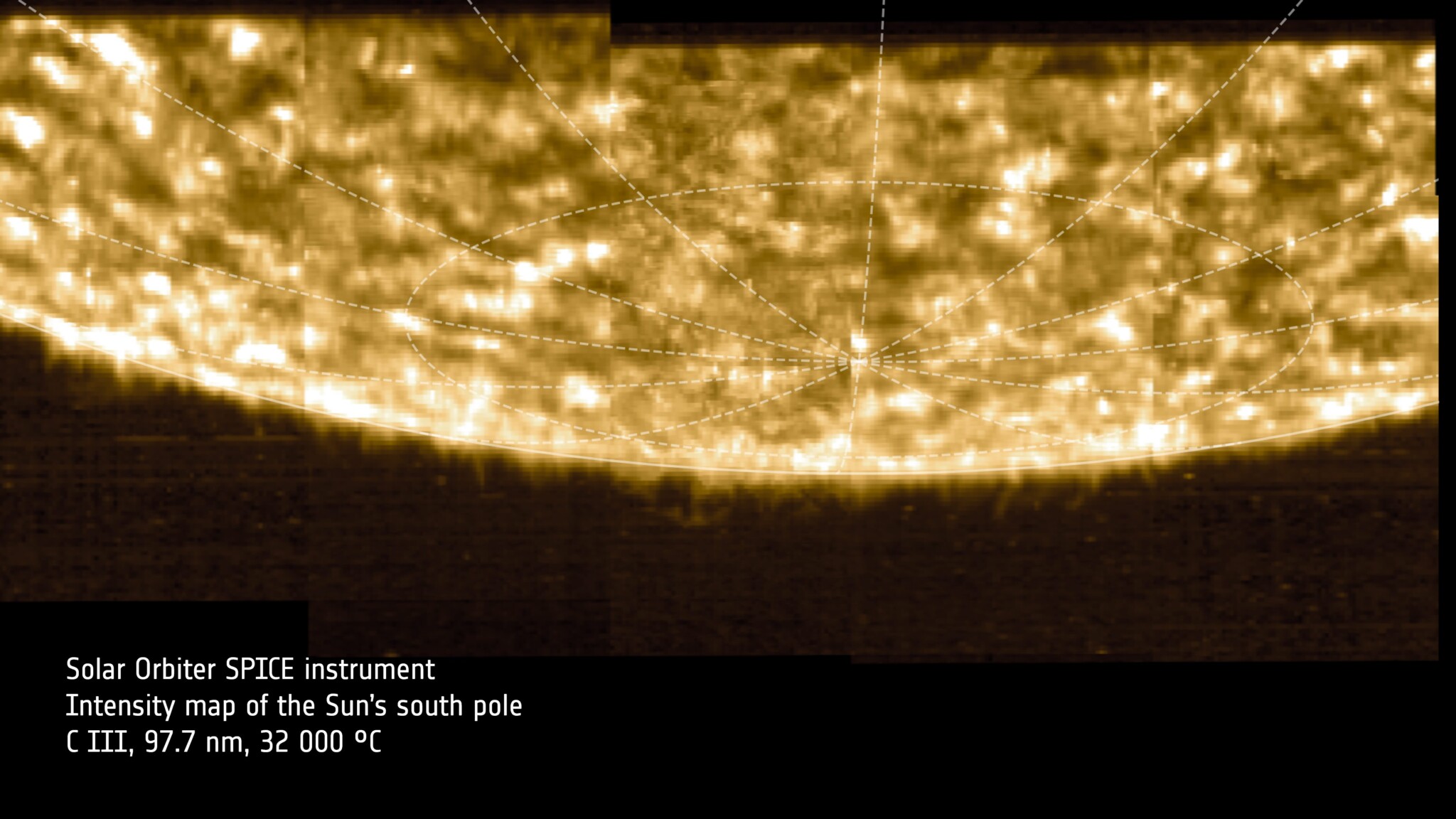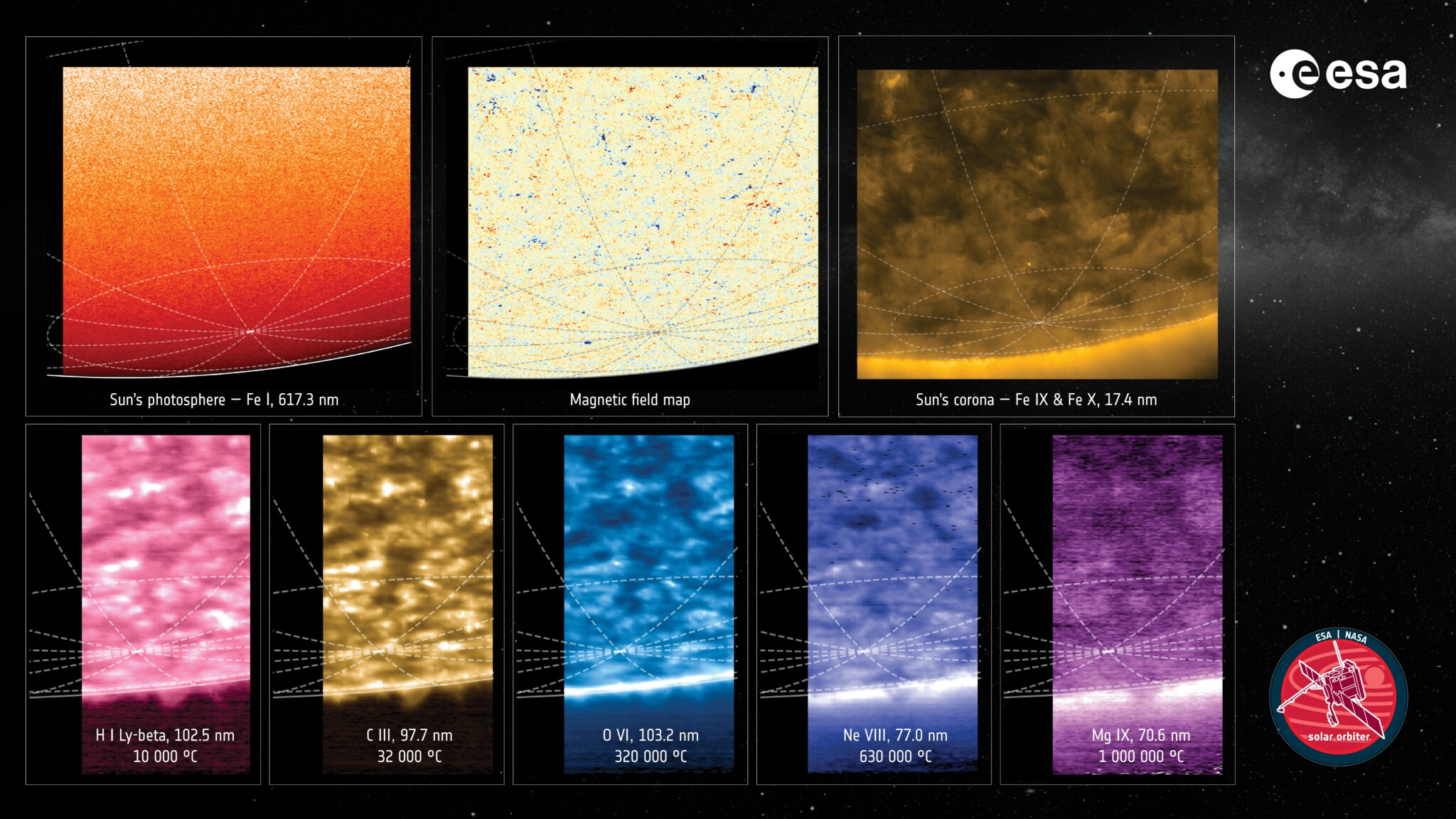Solar Orbiter captures first-ever images of the Sun’s south pole
- The European Space Agency and NASA mission has analysed the different layers of the Sun’s atmosphere and the magnetic field at its surface
- The new data will improve current models for predicting the solar activity cycle
- IEEC researchers at the Institute of Cosmos Sciences participate in this mission

The Solar Orbiter mission, a joint initiative between the European Space Agency (ESA) and NASA, has captured the first detailed images of the Sun’s south pole—a region previously unexplored. These groundbreaking observations were possible thanks to the spacecraft’s inclined orbit and its advanced instrumentation, which allows scientists to study the different layers of the solar atmosphere and measure the magnetic field at the Sun’s surface. The Institute of Space Studies of Catalonia (IEEC — Institut d’Estudis Espacials de Catalunya) collaborates in this mission with researchers at the Institute of Cosmos Sciences of the University of Barcelona (ICCUB).
The Sun has a highly dynamic magnetic field that follows a cycle of approximately 11 years. During this period, solar activity—such as sunspots, solar flares, and coronal mass ejections—increases and decreases. At the midpoint of the cycle, a fascinating phenomenon occurs: the reversal of the Sun’s magnetic field polarity. This means that the magnetic north pole becomes south, and vice versa.
This process is neither instantaneous nor uniform. It begins with a reorganization of the magnetic field at mid-latitudes and eventually affects the poles. That’s why observing the Sun’s poles is key to understanding how this reversal happens and how it influences the Sun’s behavior and space weather.
The images reveal a “messy” magnetic field at the south pole, with both positive and negative polarities present. This phenomenon is linked to the fact that the Sun is currently at the peak of its activity cycle, a phase during which the polarity of its magnetic field reverses.
The Sun’s south pole as seen by Solar Orbiter
“The new data provided by Solar Orbiter give us more insight into how the Sun’s magnetic field polarity reversal occurs, especially in regions for which we previously had no data. This is crucial for improving current models of the solar activity cycle and, consequently, for enhancing long-term predictions of solar storms,” explains Àngels Aran, IEEC researcher at the ICCUB.
These institutes have played a key role in this scientific milestone. A team led by José Maria Gómez-Cama, IEEC researcher at the ICCUB and member of the Department of Electronic and Biomedical Engineering at the University of Barcelona, was responsible for developing and implementing the Image Stabilization System (ISS) of the PHI (Polarimetric and Helioseismic Imager) instrument. This system compensates for spacecraft motion to ensure high-quality imaging, such as the recent captures of the Sun’s south pole.
Additionally, the Heliospheric Physics and Space Weather group at ICCUB and the Department of Quantum Physics and Astrophysics has provided scientific support to the team behind the Energetic Particle Detector (EPD) instrument, developing models to predict particle radiation levels during solar storms—a key factor for mission safety.
Launched in February 2020, Solar Orbiter aims to study the Sun up close and from unique perspectives, particularly its poles, to better understand its magnetic behaviour and its influence on the interplanetary environment. In the coming years, the spacecraft’s orbital inclination will gradually increase thanks to gravity-assist maneuvers around Venus. This will allow for even more detailed imaging of the solar poles, opening a new chapter in our understanding of the solar cycle and space weather.

Contacts
IEEC Communication Office
Castelldefels, Barcelona
E-mail: comunicacio@ieec.cat
Lead Researcher at the IEEC
Àngels Aran
Institute of Space Studies of Catalonia (IEEC)
Institute of Cosmos Sciences (ICCUB)
E-mail: aaran@ieec.cat, aaran@icc.ub.edu
José M. Gómez-Cama
Institute of Space Studies of Catalonia (IEEC)
Institute of Cosmos Sciences (ICCUB)
E-mail: jmgomez@ieec.cat, jmgomez@icc.ub.edu
About the IEEC
The Institute of Space Studies of Catalonia (IEEC — Institut d’Estudis Espacials de Catalunya) promotes and coordinates space research and technology development in Catalonia for the benefit of society. IEEC fosters collaborations both locally and worldwide and is an efficient agent of knowledge, innovation and technology transfer. As a result of more than 25 years of high-quality research, done in collaboration with major international organisations, IEEC ranks among the best international research centres, focusing on areas such as: astrophysics, cosmology, planetary science, and Earth Observation. IEEC’s engineering division develops instrumentation for ground- and space-based projects, and has extensive experience in working with private or public organisations from the aerospace and other innovation sectors.
The IEEC is a non-profit public sector foundation that was established in February 1996. It has a Board of Trustees composed of the Generalitat de Catalunya, Universitat de Barcelona (UB), Universitat Autònoma de Barcelona (UAB), Universitat Politècnica de Catalunya · BarcelonaTech (UPC), and the Spanish Research Council (CSIC). The IEEC is also a CERCA centre.
